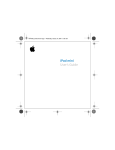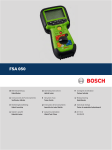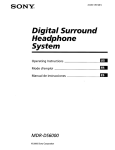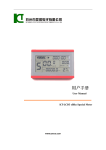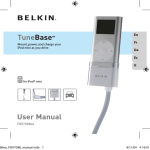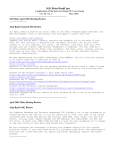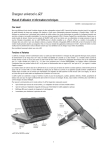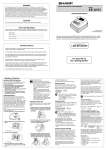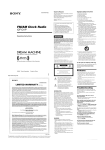Download Sony STR-DE835 Satellite Radio User Manual
Transcript
SONY:
3-279-360-31 (1)
Stereo Transmitter
Operating Instructions
----J1m
Mode d'emploi
m
Manual de instrucciones
0
oBluetooth"
TMR-BTBiP
© 2007 Sony Corporation
WARNING
To reduce the risk of fire or
electric shock, do not expose this
apparatus to rain or moisture.
Compatible iPod models
The compatible iPod models are as
follows. Update your iPod to use
the latest software before you use it.
iPod is trademark of Apple Computer. Inc.,
registered in the u.s. and other countries
The Bluetooth word mark and logos are
owned by the Bluetooth SIG, Inc. and any
use of such marks by Sony Corporation is
under license.
Other trademarks and trade names are those
of their respective owners.
iPod nano 2nd
generation
(aluminium)
iPod 5th
generation (video)
INFORMATION:
This device complies with Part 15 of FCC
Rules and RSS-Gen ofIC Rules. Operation is
subject to the following two conditions: (1)
this device may not cause interference, and
(2) this device must accept any interference,
including interference that may cause
undesired operation of this device.
iPodnano
1st generation
You are cautioned that any changes or
modifications not expressly approved in this
manual could void your authority to operate
this equipment.
iPod 4th
generation
(color display)
This equipment must not be co-located or
operated in conjunction with any other
antenna or transmitter.
This equipment complies with FCC/IC
radiation exposure limits set forth for
uncontrolled equipment and meets the FCC
radio frequency (RF) Exposure Guidelines in
Supplement C to OET65 and RSS-102 of the
IC radio frequency (RF) Exposure rules. This
equipment has very low levels of RF energy
that it is deemed to comply without testing of
specific absorption ratio (SAR).
2 us
iPod 4th
generation
iPodmini
1st generation
Notes
• This unit is designed for iPod only. You
cannot connect any other portable audio
players.
• Sony cannot accept responsibility in the
event that data recorded to iPod is lost or
damaged when using an iPod connected
to this unit.
Table of Contents
What is Bluetooth wireless
tech nology?
Features
4
5
Basic operation of Bluetooth
,.J '''',", ,: ,.."',..
UCVI~C;)
t::.
V
Location and
7
Function of Parts
Connecting to an iPod••.•...•••... 8
Pairing
10
What is pairing?
10
Pairing procedures
10
On Indicators
13
Bluetooth Connecting /
Playing back
14
Controlling by the Remote 16
Precautions •..•...•....•..••.••....•.•.. 17
Trou bleshooting......•..........••.. 19
Initializing this unit
21
Specifications•...........••..•......•.• 22
us 3
What is Bluetooth wireless technology?
Bluetooth™ wireless technology is a short-range wireless technology
that enables wireless data communication between digital devices,
such as a computer or digital camera. Bluetooth wireless technology
operates within a range of about 10 meters (about 30 feet).
Connecting two devices as necessary is common, but some devices can
be connected to multiple devices at the same time.
You do not need to use a cable for connection nor is it necessary for the
devices to face one another, such is the case with infrared technology.
For example, you can use such a device in a bag or pocket.
Bluetooth standard is an international standard supported by thousands
of companies all over the world, and employed by various companies
worldwide.
Communication System and Compatible Bluetooth Profile
of this unit
Profile is standardization of the function for each Bluetooth device
specification. This unit supports the following Bluetooth version and
profiles:
Communication System: Bluetooth Specification version 2.0 + EDR*
Compatible Bluetooth Profile:
- A2DP (Advanced Audio Distribution Profile)
- AVRCP (Audio/Video Remote Control Profile)
,.. Enhanced Data Rate
Notes
• To be able to use the Bluetooth function, the Bluetooth device to be connected
requires the same profile as the unit's.
Note also that even if the same,Profile exists, devices may vary in function
depending on their specifications.
• Due to the characteristic of Bluetooth wireless technology the sound transmitted
from this unit is slightly delayed during listening to the music.
4 us
Features
This unit is an audio transmitter using Bluetooth wireless
technology.
You can enjoy music wirelessly by transmitting the audio signals
to a Bluetooth receiving device (headset, car stereo, speaker, stereo
·r
_
....1
componenI syslem, erc.), II you connect tnlS unn to tne It'oa
(see page 2 on compatible iPod models) with the iPod connector
(30 pin).
I
•
I
\.
.1
•
_'Y'"
.,
This unit's features are as follows:
• Wireless transmitter for streaming of high-quality stereo music
from iPod.
• Transmits music to other devices using Bluetooth wireless
technology. *1
• Basic remote control operation (play, pause, etc.) of iPod
functions via Bluetooth connection. *2
• Transmitter power supplied from iPod so no additional battery or
charging is needed.
• Bluetooth Version 2.0 + EDR (Enhanced Data Rate) for higher
quality audio with less interference.
It\
*2
The connected Bluetooth device is required to support A2DP (Advanced Audio
Distribution Profile).
The connected Bluetooth device is required to support AVRCP (AudioNideo
Remote Control Profile).
iPod with dock
connector port
(30 pin)
This unit
0'
@
t2J
~..... ~ ~.
Bluetooth headset, etc.
·Q·Tip
For details on Bluetooth wireless technology, see page 4.
us 5
The following example describes how you can transmit music
played on an iPod connected to this unit, and listen on a Bluetooth
receiving device (headset).
Pairing
Enables a Bluetooth receiving device and this unit to recognize one another.
You do not need to recognize one another next time if you did once.
iPod with dock
connector port
(30 pin)
D
@
~ Bluetooth receiving
U
device (headset)
For more details, see page 10.
Bluetooth conneding
Turn on the Bluetooth receiving device and play the iPod. Bluetooth
connection is established automatically.
D
@
~
For more details, see page 14.
Listening to music
You can enjoy listening to music played on your iPod connected to this unit
through the Bluetooth receiving device.
For more details, see page 14.
6 us
Location and Function of Parts
31-------
II] iPod connector
(30 pin)
Connects to the
dock connector of an iPod
(page 8).
[2] Indicator
~ Power button
Performs the following:
• Turning onloff of this unit
(page 8).
• Pairing (page 10).
• Initializing this unit
(page 21).
Indicates this unit's status
(page 13).
us 7
Connecting to an iPod
Connect this unit to the dock connector port of an iPod firmly.
' - - - Dock connector port (30 pin)
- - Power button
To turn on this unit
1
2
Connect this unit to the iPod.
Press the power button of this unit for about 1second to turn it on,
or start to play back on iPod.
When this unit turns on, the indicator flashes twice.
Note
If the unit cannot turn on, operate the iPod.
To turn off this unit
To turn off this unit, press and hold this unit's power button for
about 1 second. The indicator flashes once and this unit turns off.
~Q*Tip
Maximum communication time or standby time may vary depending on your
iPod.
8 us
Notes
• To listen to music from the headphone jack of the iPod) disconnect this unit from
the iPod.
• While this unit is turned on) it consumes power from the iPod. We recommend
disconnect this unit from iPod when not using the Bluetooth function.
• If the headphone is connected to the iPod while the iPod is playing back) it
consumes power from iPod.
• If you turn off this unit while the iPod is playing back) iPod will power off.
• It is not recommended to turn off iPod as the linkage will lost between this unit
and the Bluetooth receiving device.
• There is no need to charge this unit as it will receive power from the connected
iPod. It is recommended to check the iPod)s remaining battery before using.
us 9
Pairing
Bluetooth devices need to be "paired" with each other beforehand.
Once Bluetooth devices are paired, there is no need for pairing
again, except in the following cases:
• Pairing information is deleted after repair, etc.
• This unit is paired with 9 or more receiving devices.
This unit can be paired with up to 8 Bluetooth receiving device. If a
new device is paired after 8 devices have been paired, the device whose
latest connection time is the oldest among the 8 paired devices is
replaced by the new one.
• This unit is initialized.
All pairing information is deleted (page 21).
1. Turn on the power of iPod.
(Make sure the iPod is in pause mode)
2
3
Connect this unit to the iPod (page 8).
Place this unit and the Bluetooth receiving device to be paired
together within 1m(3 tt).
4
Set the Bluetooth receiving device to enter "Pairing in process:'
See the operating instructions supplied with the Bluetooth receiving
device.
·Q·Tip
For Sony Wireless Stereo Headset
10 us
Press and hold the POWER button of the bluetooth receiving
device for 7 seconds or more to standby for pairing while the
unit is turned off.
Notes
• Passcode* of this unit is fixed at "0000': "1234" or "8888:' Depending on the
Bluetooth receiving device, it may be necessary to input the passcode (in
this case, "DODO': "1234" or "8888"). This unit cannot be paired with a
Bluetooth receiving device whose passcode is not "0000': "1234" or "8888."
• If the Bluetooth receiving device requires a passcode, input "0000:'
>I-
Passcode may be called "Passkey:' "PIN code;' "PIN number:' or "Password:'
S Press and hold the power button of this unit for 7seconds or mor~ to
enter IJPairing in process:'
After about 1 second, the indicator will flash twice but keep
pressing the power button.
Notes
• When first power on this unit after initialize, this unit will enter the "Pairing
in process" automatically.
• The pairing information is initialized if you press and hold the power
button for 15 seconds. The indicator lights up for 5 seconds before the
initialization starts. Release the button immediately when the indicator
lights up.
When the indicator of this unit flashes quickly, stop pressing it.
This unit enters ((Pairing in process:'
This unit's indicator status will vary as follows, and pairing is
established with the Bluetooth receiving device.
Continued r==">.
us 11
Indicator flashes quickly: Pairing in process
Indicator flashes (at about I-second interval) when responding to
the Bluetooth receiving device: Connectable
(Paring successful)
"'"
Indicator flashes (at about 5-second intervals): Connected
Notes
"'"
• "Pairing in process" of this unit is released after about 5 minutes. If pairing is
not established within about 5 minutes, repeat the above procedure from step
4. iPod backlight may turn on in this 5 minutes.
• To enter "Pairing in process;' you need to turn off the power of this unit and
turn on the power of iPod first.
When not completed pairing
Repeat the procedure from step 2.
To quit "Pairing in process"
Press and hold the power button of this unit for about 1 second to
turn off this unit.
~Q·Tip
When paring this unit with a number of Bluetooth receiving devices, repeat steps 3
to 5 for each device individually.
Note
For using the Bluetooth function, it is required that the Bluetooth device on the
other side is corresponding with the same profile as this unit. However, even if it is
corresponding with the same profile, functions may differ depending on the
specification of the Bluetooth device.
12 us
On Indicators
Status
Indicator
Flashes twice~,,~.}
Flashes once·'·
'H
*2
..
Flashes quickly
~'.~IJ\'~~')~\'
Flashes
(at about 1second intervals)
11) - ;I) -
Listening *I
(flashes twice at
about 5-second
intervals)
tW~l'11
With no music *2
(flashes once at
about 5-second
intervals)
ill'\ - - - - - .' - - - - - ...
,I) -.~ - Ili - ...
- - - - - ~'}\/I\t - - - - - ...
When press ~II on the iPod, the music pause. The indicator flashes twice on this
unit. This unit transmit the data of no sound.
When press the pause button on the Bluetooth receiving device, the music pause.
The indicator flashes once on this unit. This unit does not transmit the music.
us 13
listening to music:
Bluetooth Connecting I Playing back
You can listen to music of the iPod connected to this unit on the
Bluetooth receiving device (headset, etc.).
Before starting operation, complete pairing this unit and the
Bluetooth receiving device (page 10).
1
The Bluetooth receiving device is on standby for connection.
2
Connect this unit to the iPod then turn on the iPod and start
playback on the iPod.
This unit's indicator status will vary as follows, and the Bluetooth
connection between this unit and the Bluetooth receiving device
is established.
Indicator flashes twice: Power is on
.J
Indicator flashes (at about I-second intervals): Connecting
In process
.J
Indicator flashes twice slowly (at about 5-second intervals):
Connected
(Playback will start automatically)
If the Bluetooth connection is not established within 5 minutes*,
this unit automatically turns itself off. In this case, turn it on
again by pressing and holding the power button for about
1 second.
>\-
iPod backlight may turn on in this 5 minutes.
Notes
• If the Bluetooth connection cannot be established with the device paired
already, try pairing again.
• If playback cannot start automatically, try start playback on iPod.
• If you press and hold the power button on this unit for about 1 second, this
unit will connect to the iPod and start playback automatically.
14 us
·Q*Tip
You can control the volume on the Bluetooth receiving device.
(The volume of the iPod is not changed.)
Notes
• Even if you control the volume on the iPod, sound from the Bluetooth receiving
device will not change.
e
If tliis unit and the Bluetooth receiving de'·,rice become out of range and the
Bluetooth connection terminates, repeat the procedure from step 1.
• Playback through a Bluetooth connection may cause noise, sound break, or
playback speed change depending on the location and the usage (page 17).
us 15
Controlling by the Remote
When connecting (Bluetooth connecting) to devices that
support AVRCP (AudioNideo Remote Control Profile)
You can control the iPod using the control button of the Bluetooth receiving device.
For details, see the operating instructions supplied with the Bluetooth devices.
Before starting remote control operation, check that step 1 and 2 of
IIBluetooth Connecting! Playing back" are completed (page 14).
Remote control for the iPod by the Bluetooth receiving device.
D
@
~
~~
~ ~ .... ... ... P
U
Headset with AVRCP
Remote control
(play, pause, etc.)
Notes
• Even if you control the volume on the iPod, the volume of the Bluetooth
receiving device, such as a headset, does not change.
• When operating the iPod by remote control, do not cover this unit with hands.
• You may need to press the play/pause button twice depending on the Bluetooth
receiving device.
• You may need to press the play/pause button of the Bluetooth receiving device
twice when you operate the button on the iPod.
• Operation of the iPod with this unit by the Bluetooth receiving device will vary
depending on the Bluetooth receiving device's specification.
'Q*Tip
When you press the pause button on the Bluetooth receiving device, the iPod goes
to pause mode for 10 minutes and the iPod backlight is turns on and off at interval.
1°
I@
Do not cover this
unit with hands.
16 us
Precautions
On Bluetooth communication
• Bluetooth wireless technology
operates within a range of about 10
meters (about 30 feet). Maximum
communication range may vary
depending on obstacles (human body,
metal, wall, etc.) or electromagnetic
environment.
Optimal performance
Limited performance
• The aerial of this unit is shown
as illustrated in the dotted line.
The sensitivity of Bluetooth
communication will improve by
turning the direction of the built-in
aerial to the connected Bluetooth
device.
The communication distance shortens
when the obstacles are between the
aerial of the connected device and
this unit.
• The following conditions may cause
noise, sound break or playback speed
change.
- When using inside the metal bag.
"'{AT1.
-
VV 11C::11
~,
~
~.J
_ LL _ L __ 1.
U~lIlg lIl~lUC::
1..
LUC:: U<iLKp,U":K
_ ..
ur
shoulder bag.
- A device using 2.4 GHz frequency,
such as a wireless LAN device,
cordless telephone, or microwave
oven, is ill use near this unit.
• Because Bluetooth devices and wireless
LAN (IEEE802.11b/g) use the same
frequency, microwave interference may
occur and resulting in communication
speed deterioration, noise, or invalid
connection if this unit is used near a
wireless LAN device. In such a case,
perform the following.
- Install this unit and Bluetooth device as
near to each other as possible.
- If this unit is used within about
10 meters (about 30 feet) of a wireless
LAN device, turn off the wireless
LAN device.
• Microwaves emitting from a Bluetooth
device may affect the operation of
electronic medical devices. Turn off
this unit and other Bluetooth devices
in the following locations, as it may
cause an accident.
- where inflammable gas is present, in
a hospital, train, airplane, or a petrol
station.
- near automatic doors or a fire alarm.
Location of
built-in aerial
(ontinued~
US
17
• This unit supports security capabilities
that comply with the Bluetooth
standard to provide a secure
connection when the Bluetooth
wireless technology is used, but
security may not be enough depending
on the setting. Be careful when
communicating using Bluetooth
wireless technology.
• We do not take any responsibility
for leakage of information during
Bluetooth communication.
• Connection with all Bluetooth devices
cannot be guaranteed.
- A device featuring Bluetooth
function is required to conform to
the Bluetooth standard specified
by Bluetooth SIG, Inc. and be
authenticated.
- Even if the connected device
conforms to the above mentioned
Bluetooth standard, some devices
may not be connected or work
correctly, depending on the features
or specifications of the device.
• Depending on the device to be
connected, communication may take
some time.
On safety
• Do not drop, hit, or otherwise expose
the unit to strong shock of any kind.
This could damage the product.
• Do not disassemble or attempt to open
any parts of the unit.
18 us
On placement
• Do not place the unit in any of the
following locations.
- Direct sunlight, near a heater, or
other extremely high-temperature
location
- Dusty location
- An unsteady or inclined surface
- Location exposed to large amounts
of vibration
- Bathroom or other high-humidity
location
- In a car subject to the direct rays of
the sun
• •
Notes on uSing
In acar
Do not attempt to connect this unit, or
to operate this unit, an audio output
device or a car radio while driving or
waiting at a traffic signal.
Cleaning
Clean the unit with a soft, dry cloth,
or a soft cloth lightly moistened with
a mild detergent solution. Do not use
any type of solvent, such as alcohol
or benzene, which may damage the
finish.
Others
If you have any questions or problems
concerning this unit that are not
covered in this manual, please consult
your nearest Sony dealer.
Troubleshooting
If you run into any problems using this unit, use the following
checklist and read the product support information on our website.
Should any problem persist, consult your nearest Sony dealer.
Symptom
Cause I Remedy
This unit is not
turned on.
(or turns off
shortly after
turning on.)
-+ Press and hold this unit power button for about 1
-+
No sound
-+ Check the connection between this unit and the
-+
-+
-+
-+
-+
Low sound level
second.
Check the remaining battery of the iPod. If the
remaining battery is not enough, charge the iPod.
Reset your iPod.
If your iPod have no content, add some content to
your iPod.
iPod.
Check that both this unit and the Bluetooth
receiving device are turned on.
Ensure that this unit is not too far from the
Bluetooth receiving device, or this unit is not
receiving interference from a wireless LAN, other
2.4 GHz wireless device, or microwave oven.
Pair this unit and the Bluetooth receiving device
again.
-+ Turn up the volume of the Bluetooth receiving
device as high as possible to the extent that sound
is not distorted. For details on volume adjustment,
refer to the operating instructions supplied with the
Bluetooth receiving device.
Cannot change the
volume.
-+ Change the volume on the Bluetooth receiving
device.
Continued~
us 19
Symptom
Cause I Remedy
Distorted sound
~
~
~
Sound break,
noise or playback
speed change
~
~
~
~
~
Pairing cannot be
established.
~
~
Bluetooth
connection cannot
be established
with a device that
has been «paired"
before.
~
~
~
20 us
Turn down the volume of the Bluetooth receiving
device to the point where the sound is no longer
distorted. For details on volume adjustment, refer
to the operating instructions supplied with the
Bluetooth receiving device.
Turn off the EQ of iPod.
Ensure that this unit is not receiving interference
from a wireless LAN, other 2.4 GHz wireless device,
or microwave oven.
If a device that generates electromagnetic radiation,
such as a wireless LAN, other Bluetooth device(s),
or a microwave oven is nearby, move away from
such sources.
Remove any obstacle between this unit and other
Bluetooth device or move away from the obstacle.
Locate this unit and other Bluetooth device(s) as
near as possible.
Re-position or re-orient this unit.
Re-position or re-orient other Bluetooth device.
Locate this unit and other Bluetooth device(s) as
near as possible.
Check if you input correct passcode (page 11).
Locate this unit and other Bluetooth device(s) as
near as possible.
This unit tries to connect with either of the last
two devices recognized before. If this unit cannot
establish the Bluetooth connection with a paired
device, operate the connecting procedures on the
Bluetooth receiving device or pair the device again.
Pairing information may be deleted. Pair the device
again.
Initializing this unit
You can reset this unit to its default and delete all pairing
information.
1 Connect the unit to the iPod.
2 Press and hold the power button for more than about 1Sseconds.
During these 15 seconds) the indicator changes in sequence as
follows:
- flash (at about 1 second intervals) for about 5 seconds
- flash quickly for about 5 seconds
- lights up for about 5 seconds
- flash 4 times
Then) the unit is reset to default setting and all pairing
information is deleted.
Note
Do not operate your iPod while initializing this unit.
us 21
Specifications
General
,.3
Communication System
Bluetooth Specification Version 2.0 +
EDR*1
*4
,.5
Output
Bluetooth Specification Power Class 2
Bluetooth standard profiles indicate the
purpose of Bluetooth communication
between devices.
Codec: Audio Signal compression and
conversion format
Subband Codec
Maximum communication range
Supplied accessories
Line of sight approx. 10 m (30 ft)*2
Operating instructions (this book) (1)
Frequency band
2.4 GHz band (2.4000 GHz - 2.4835 GHz)
Modulation method
FHSS
Transmission range (A2DP)
20 - 20,000 Hz (Sampling frequency
44.1 kHz)
Compatible Bluetooth Profiles,..3
A2DP (Advanced Audio Distribution
Profile)
AVRCP (Audio/Video Remote
Control Profile)
Supported Codec*4
SBC*5
Terminal
iPod connector (30 pin)
Operating temperature
o °C to 35°C (32 of to 95 of)
Dimensions
Approx. 31 x 28 x 8 mm
(11/ 4 x 11/s X 11132 in.) (w/h/d)
(including protruding parts)
Mass
Approx. 5 g (0.2 oz)
,. 1
,.2
22 us
Enhanced Data Rate
The actual range will vary depending on
factors such as obstacles between devices,
magnetic fields around a microwave oven,
static electricity, reception sensitivity,
aerial's performance, operating system,
software application, etc.
Design and specifications are subject
to change without notice.
http://www.sony.netlllll
II "" II " 111111"
Printed in Malaysia
2
*
3
7
9
3
6
0
3
1
*
:
(1 )
-
I111II111111111111111111111111111111111111111111111111111111
S 0 NY®
4-557-147-13
Tape Cassette Player/Recorder/CD Player/Mini Disc
DAT/Radio/Head Phone/Speaker/MIC/Personals
IPortable Audiol
LIIMITED WARRANTY (u.s.
Only)
Sony Electronics Inc. ("Sony") warrants this product against defects in material or workmanship for the time
periods and as set forth below. Pursuant to this Limited Warranty, Sony will, at its option, (i) repair the product
using new or refurbished parts or (ii) replace the product with a new or refurbished product. For purposes of this
Limited Warranty, "refurbished" means a product or part that has been returned to its original specifications. In
the event of a defect, these are your exclusive remedies.
labor: For a period of ninety (90) days from the original date of purchase of the product ("Labor Warranty"),
Sony will, at its option, repair or replace with new or refurbished product, product determined to be defective. If
Sony elects to replace the product after this Labor Warranty has expired but while the Parts Warranty below is
still in effect, it wiill do so for the applicable labor charge.
Parts: For a period of one (1) year from the original date of purchase of product ("Parts Warranty"), Sony will
supply new or refurbished replacement parts in exchange for parts determined to be defective.
This Limited Warranty covers only the hardware components packaged with the Product. It does not cover
technical assistance for hardware or software usage and it does not cover any software products whether or not
contained in the Product; any such software is provided"AS IS" unless expressly provided for in any enclosed
software Limited Warranty. Please refer to the End User License Agreements included with the Product for your
rights and obligations with respect to the software.
Instructions: To obtain warranty service, you must deliver the product, freight prepaid, in either its original
packaging or packaging affording an equal degree of protection to the Sony authorized service facility specified.
It is your respolilsibility to backup any data, software or other materials you may have stored or preserved on your unit. It is likely that such data, software, or other materials will be lost or reformatted
during service and Sony will not be responsible for any such damage or loss. A dated purchase receipt is
required. For specific instructions on how to obtain warranty service for your product,
Visit Sony's Web Site:
www.sony.com/service
Or call the Sony Customer Information Service Center
1-800-222-S0NY (7669)
For an accessory or part not available from your authorized dealer, call:
1-800-488-S0NY (7669)
Repair I ReplacE!ment Warranty: This Limited Warranty shall apply to any repair, replacement part or replacement product for the remainder of the original Limited Warranty period or for ninety (90) days, whichever is
longer. Any parts or product replaced under this Limited Warranty will become the property of Sony.
This Limited Warranty only covers product issues caused by defects in material or workmanship during ordinary
consumer use; it does not cover product issues caused by any other reason, including but not limited to product
issues due to commercial use, acts of God, misuse, limitations of technology, or modification of or to any part of
the Sony product. This Limited Warranty does not cover Sony products sold AS IS or WITH ALL FAULTS or
consumables (such as fuses or batteries). This Limited Warranty is invalid if the factory-applied serial number
has been altered or removed from the product. This Limited Warranty is valid only in the United States.
LIMITATION ONI DAMAGES: SONY SHALL NOT BE LIABLE FOR ANY INCIDENTAL OR CONSEQUENTIAL
DAMAGES FOR BREACH OF ANY EXPRESS OR IMPLIED WARRANTY ON THIS PRODUCT.
DURATION OF IMPLIED WARRANTIES: EXCEPT TO THE EXTENT PROHIBITED BY APPLICABLE LAW, ANY
IMPLIED WARRANTY OF MERCHANTABILITY OR FITNESS FOR A PARTICULAR PURPOSE ON THIS PRODUCT
IS LIMITED IN DURATION TO THE DURATION OF THIS WARRANTY.
Some states do not allow the exclusion or limitation of incidental or consequential damages, or allow limitations
on how long an implied warranty lasts, so the above limitations or exclusions may not apply to you. This Limited
Warranty gives you specific legal rights and you may have other rights which vary from state to state.
Printed in Malaysia

























